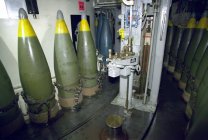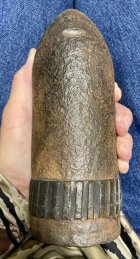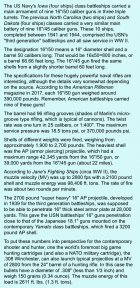Don’t matter, watch that video you’ll see the drive band that engages rifling.Yeah, very deep. I wonder what the jacketing material was?
You are using an out of date browser. It may not display this or other websites correctly.
You should upgrade or use an alternative browser.
You should upgrade or use an alternative browser.
Naval gun rifling cutter photo's
- Thread starter Gun Smith
- Start date
jackieschmidt
Gold $$ Contributor
I have read where the big naval guns use a progressive, or gain twist.What's the twist rate?
As shells got heavier, due to the shear inertia to start the shell twisting, the twist had to gradual.
Last edited:
Steel. But the rifling never engraves the steel. There are “rotating bands” usually of gilding metal swaged on to the base of the projectile. These don’t rotate, but they cause the projectile to rotate while in the bore. Here is a photo of the ready rack in a battleship turret. The brown band at the base is the rotating band,Yeah, very deep. I wonder what the jacketing material was?
Attachments
hogpatrol
Gold $$ Contributor
Begs the question, bronze or nylon?
OT/ Back in the bad old days, I ran an old WW2 surplus gun lathe. Used it to turn the bearing journals on steel mill rolls. The bed was 20' long, no rapid traverse, engaged the half nut to move it to the end or you'd be cranking that big wheel for a looong time. Man, I'm glad I don't have to do that anymore.
OT/ Back in the bad old days, I ran an old WW2 surplus gun lathe. Used it to turn the bearing journals on steel mill rolls. The bed was 20' long, no rapid traverse, engaged the half nut to move it to the end or you'd be cranking that big wheel for a looong time. Man, I'm glad I don't have to do that anymore.
What's the twist rate?
jackieschmidt
Gold $$ Contributor
These Rifle Barrels were also designed to be “relined“ after so many rounds, which I believe were about 350 to 400.
dave@aDave
Gold $$ Contributor
These were actually quite interesting rifles. Projectile range was determined by barrel elevation and how many 110 lb silk bags were used. Maximum of 6 bags. One shot would pretty much use up my yearly allowance of powder
https://en.wikipedia.org/wiki/16"/50_caliber_Mark_7_gun
https://en.wikipedia.org/wiki/16"/50_caliber_Mark_7_gun
One of the more interesting threads and some good links. WH
snert
Silver $$ Contributor
Yes. If two sailors could pick it up, it passed. If it took three, they might need to tweak the load with an extra 110 pounds or so....Think they sort the bullets ? Obviously I knew they had guns but never sat and looked at the info... amazing stuff , says these were retired in 92... must have been upgraded... that really makes me scratch my noggin...
They actually fired a lot more than that. Reclining was a major process, as these were “built-up” guns with many tubes shrunk together to make the reinforcements necessary. The system that made up the tube assembly were liner, tube, jacket, three hoops, two locking rings, tube and liner locking ring, yoke ring and screw box liner. Some of these had interferences that would permanently deform the material to strengthen it call “autofrettage”. It was probably cheaper to just replace the whole tube.These Rifle Barrels were also designed to be “relined“ after so many rounds, which I believe were about 350 to 400.
I think only a relatively narrow brass drive band incorporated into the body takes much engraving.Yeah, very deep. I wonder what the jacketing material was?
joshb
Gold $$ Contributor
Large Magnum at least.Just wondering if they use large or small rifle primers??
It's incredible to think of the precision of the machining of some of our largest machines.
Similar threads
- Replies
- 1
- Views
- 427
- Replies
- 31
- Views
- 2,060
Upgrades & Donations
This Forum's expenses are primarily paid by member contributions. You can upgrade your Forum membership in seconds. Gold and Silver members get unlimited FREE classifieds for one year. Gold members can upload custom avatars.

Click Upgrade Membership Button ABOVE to get Gold or Silver Status.
You can also donate any amount, large or small, with the button below. Include your Forum Name in the PayPal Notes field.
To DONATE by CHECK, or make a recurring donation, CLICK HERE to learn how.

Click Upgrade Membership Button ABOVE to get Gold or Silver Status.
You can also donate any amount, large or small, with the button below. Include your Forum Name in the PayPal Notes field.
To DONATE by CHECK, or make a recurring donation, CLICK HERE to learn how.












